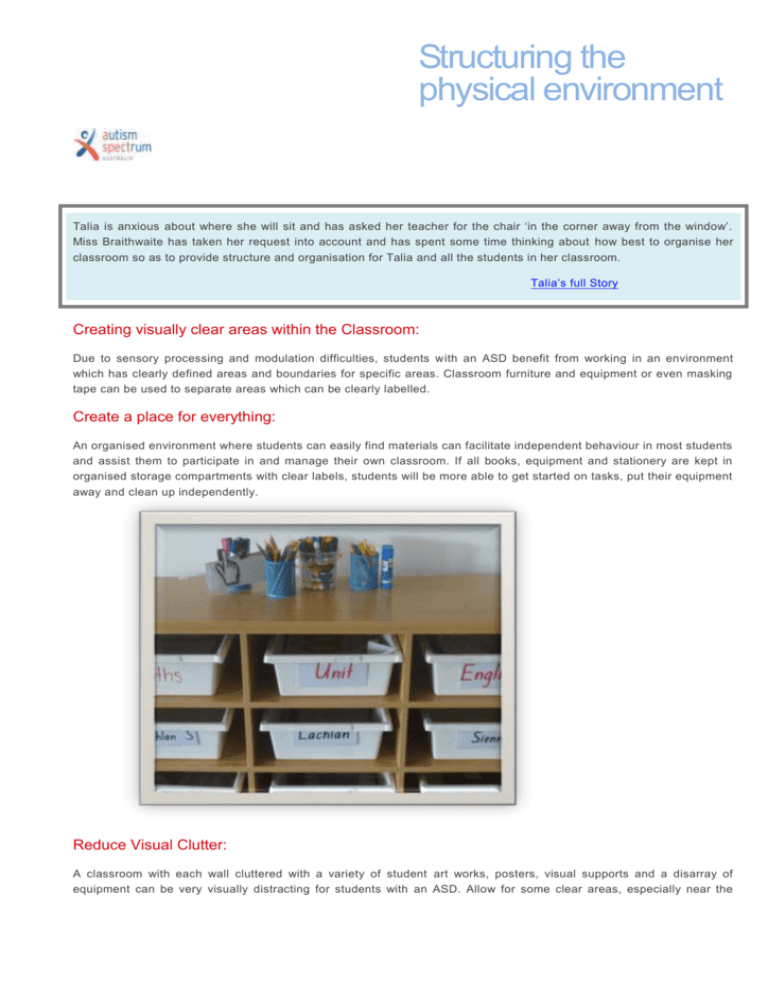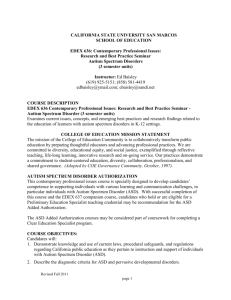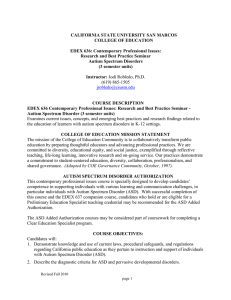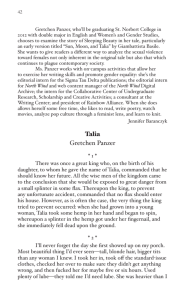Structuring the physical environment (doc
advertisement

Structuring the physical environment Talia is anxious about where she will sit and has asked her teacher for the chair ‘in the corner away from the window’. Miss Braithwaite has taken her request into account and has spent some time thinking about how best to organise her classroom so as to provide structure and organisation for Talia and all the students in her classroom. Talia’s full Story Creating visually clear areas within the Classroom: Due to sensory processing and modulation difficulties, students with an ASD benefit from working in an environment which has clearly defined areas and boundaries for specific areas. Classroom furniture and equipment or even masking tape can be used to separate areas which can be clearly labelled. Create a place for everything: An organised environment where students can easily find materials can facilitate independent behaviour in most students and assist them to participate in and manage their own classroom. If all books, equipment and stationery are kept in organised storage compartments with clear labels, students will be more able to get started on tasks, put their equipment away and clean up independently. Reduce Visual Clutter: A classroom with each wall cluttered with a variety of student art works, posters, visual supports and a disarray of equipment can be very visually distracting for students with an ASD. Allow for some clear areas, especially near the seating areas of students with an ASD, and interchange art works and student displays so as to avoid a visual overload. If there are disorganised areas with a range of books, unfinished projects or props for an upcoming school production, the teacher can use a sheet or tarp to cover the look of disorganisation (Kluth, 2010). Lighting Some students are hypersensitive to bright lights or fluorescent lights. This may adversely affect their reading ability, concentration and behaviour within the classroom. Take periodic breaks to have everyone close their eyes for 60 seconds. Use as much natural light as much as possible or alternatively try to use lower levels of light. Place the student with an ASD in a comfortable spot within the classroom, taking advantage of natural lighting where possible. Bear in mind that it is often not the lights themselves but the reflection of light on a wall or other surface that may be bothersome (Kluth, 2010). Sunglasses or tinted glasses may be worn inside the classroom depending on the severity of the sensitivity. Alternatively, coloured overlays may be used to soften the glare of lighting on white paper. Sound Students with an ASD can often be highly sensitive to and distracted by sounds that their peers may not even notice such as a train far away or the high pitch of a teacher’s voice. They can also become distressed at the sound of loud unexpected noises such as the sound of a bell or lawnmower and will usually cup their ears to try and filter out the sound. Reduce classroom noise where possible by installing a carpet to reduce echoing as well as the scrapi ng of chairs on the floor as well as closing windows and doors where necessary (Kluth, 2010). Allow the student to listen to calming music on his/her own digital audio or play music for all the students. The student may also be allowed to wear earplugs or headphones at certain times to filter out undesired noise but still hear what the teacher may be saying. Where possible, warn the student of the noise such as when a fire drill siren may be about to ring . Encourage the student to let you know when a particular noise is distracting or painful. Temperature Students with an ASD may react differently to temperatures. They may also have tactile sensitivities which may make it uncomfortable to wear parts of the school uniform such as a jumper etc. As it is not always possible to adjust classroom temperatures, encourage students to bring in a range of items of clothing so as to make themselves comfortable throughout the school day. If a student is usually hot, provide a bottle of cold water and perhaps even a p ortable fan on their desk. Place the student in a cooler section of the room such as near a window. Try and circulate air in the classroom as much as possible. Smells Smells which may not even be detected by other students may cause great discomfort to st udents who are hypersensitive in this area. Students may be highly sensitive to the smell of perfumes, after shaves and heavily scented deodorants of their teachers and peers. Ensure that the use of these is restricted as far as possible. Where possible, store strong smelling items such as glues and paints as far away from the student as possible. Some students may be sensitive to food smells. Teachers can, therefore, ensure that lunches are stored outside the classroom. Where possible, the placement of a student with olfactory/smell sensitivities in a classroom very close to the school canteen should be avoided. For further information: Sensory processing difficulties References: Kluth, P. 2010, “You’re Going to Love this Kid!” Teaching Students with Autism in the Inclusive Classroom, Baltimore, Paul H. Brookes Publishing Co. Smith, T. 2012, Making Inclusion Work for Students with Autism Spectrum Disorders: An Evidence-Based Guide, NY, The Guilford Press. Walker, D. 2010, Educational Outreach Resources, Autism Spectrum Australia (Aspect), Sydney.










